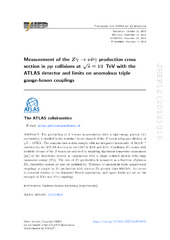Measurement of the Zγ→νν¯¯γ production cross section in pp collisions at √s=13 TeV with the ATLAS detector and limits on anomalous triple gauge-boson couplings
Aaboud, Morad; Aad, Georges; Abbott, Brad; Abdinov, Ovsat Bahram oglu; Abeloos, Baptiste; Abhayasinghe, Deshan Kavishka; Abidi, Syed Haider; AbouZeid, Hass; Abraham, Nadine L.; Abramowicz, Halina; Buanes, Trygve; Eigen, Gerald; Fomin, Nikolai; Lipniacka, Anna; Martin dit Latour, Bertrand; Mæland, Steffen; Stugu, Bjarne; Yang, Zongchang; Zalieckas, Justas; Bugge, Magnar Kopangen; Cameron, David Gordon; Catmore, James Richard; Feigl, Simon; Franconi, Laura; Garonne, Vincent; Gramstad, Eirik; Hellesund, Simen; Morisbak, Vanja; Oppen, Henrik; Ould-Saada, Farid; Pedersen, Maiken; Read, Alexander Lincoln; Røhne, Ole Myren; Sandaker, Heidi; Serfon, Cédric; Stapnes, Steinar; Vadla, Knut Oddvar Høie; Abreu, Henso; Abulaiti, Yiming; Acharya, Bobby S.; Adachi, Shunsuke; Adam, Lennart; Adamczyk, Leszek; Adelman, Jareed; Adersberger, Michael; Adigüzel, Aytül; Adye, Tim; Affolder, Anthony Allen; Afik, Yoav; Agheorghiesei, Catalin; Zwalinski, L; ATLAS, Collaboration
Peer reviewed, Journal article
Published version

Åpne
Permanent lenke
https://hdl.handle.net/1956/23651Utgivelsesdato
2018Metadata
Vis full innførselSamlinger
Originalversjon
https://doi.org/10.1007/jhep12(2018)010Sammendrag
The production of Z bosons in association with a high-energy photon (Zγ production) is studied in the neutrino decay channel of the Z boson using pp collisions at s√=13 TeV. The analysis uses a data sample with an integrated luminosity of 36.1fb−1 collected by the ATLAS detector at the LHC in 2015 and 2016. Candidate Zγ events with invisible decays of the Z boson are selected by requiring significant transverse momentum (pT) of the dineutrino system in conjunction with a single isolated photon with large transverse energy (ET). The rate of Zγ production is measured as a function of photon ET, dineutrino system pT and jet multiplicity. Evidence of anomalous triple gauge-boson couplings is sought in Zγ production with photon ET greater than 600 GeV. No excess is observed relative to the Standard Model expectation, and upper limits are set on the strength of ZZγ and Zγγ couplings.
